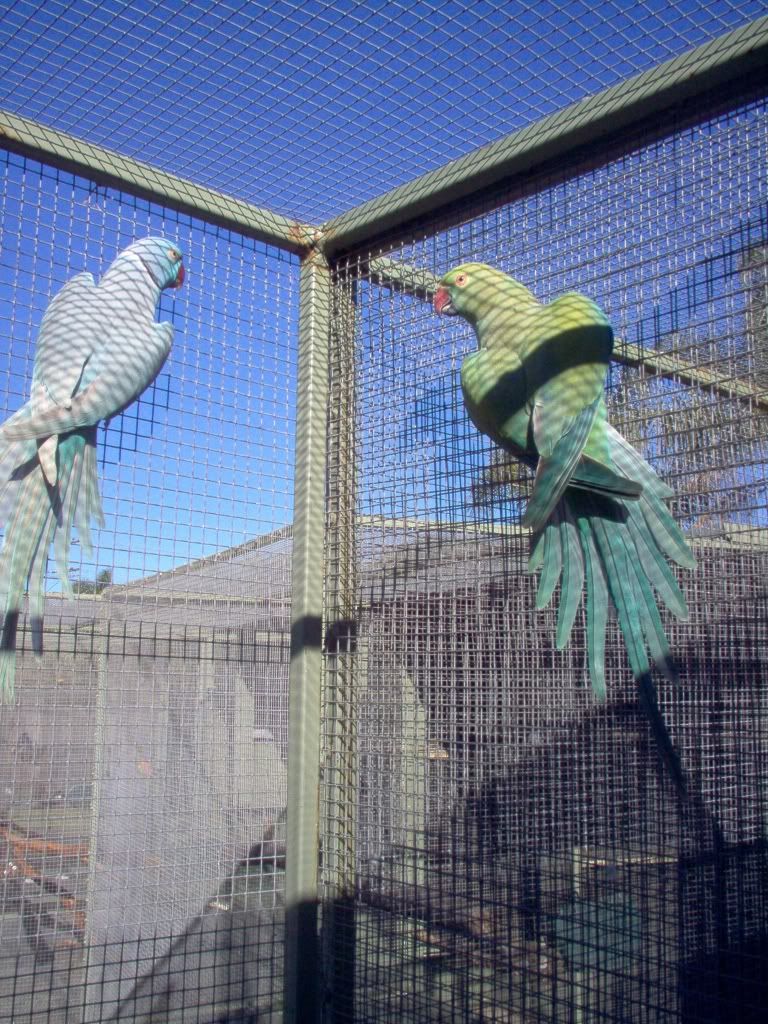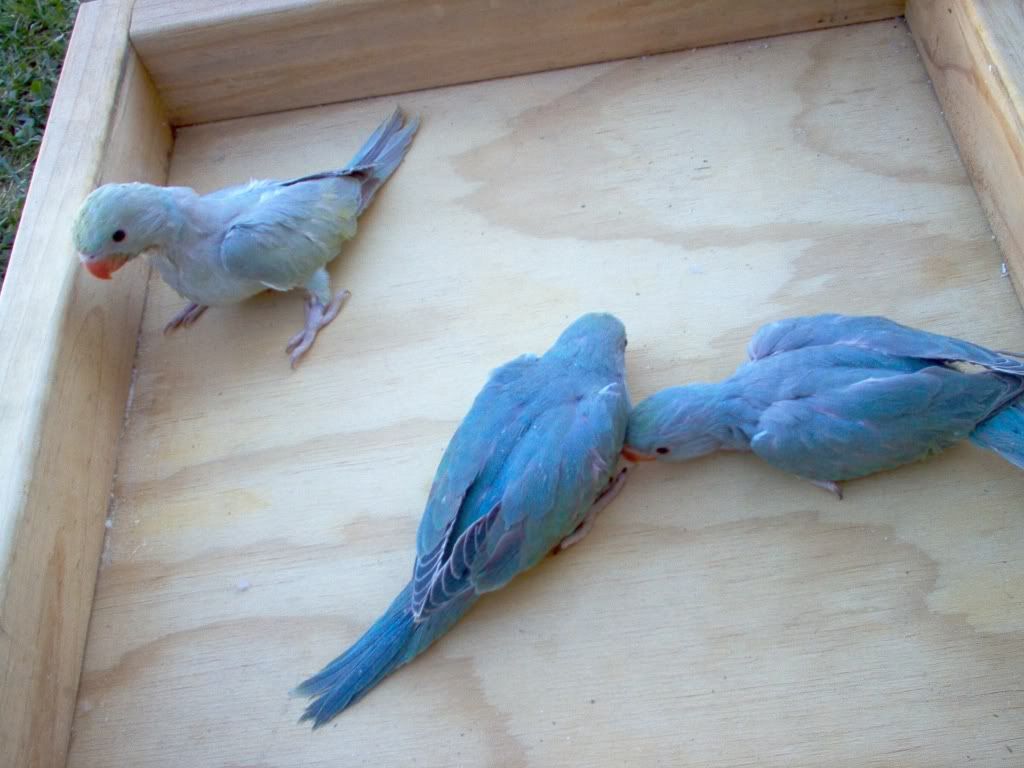Genetics - ???Pastel Blue sex-linked cockbird???
Moderator: Mods
Genetics - ???Pastel Blue sex-linked cockbird???
Hi all,
I'm of the understanding that being a recessive gene in ringnecks you can't have a guaranteed sex-linked pastel blue cockbird just by visually inspecting?
Can anyone confirm this belief or can you visually guarantee this outome?
Cheers
I'm of the understanding that being a recessive gene in ringnecks you can't have a guaranteed sex-linked pastel blue cockbird just by visually inspecting?
Can anyone confirm this belief or can you visually guarantee this outome?
Cheers
I have never come across a Sex-Linked Recessive Turquoise (pastel) in Indian Ringnecks.
Turquoise is an Autosomal Recessive (co-dominant with blue) gene. Blue is also Autosomal Recessive. Neither are Sex-Linked Recessive.
In regards to the wild type (green) if you put a turquoise blue with it.. all young are green with either split for blue, or split for turquoise (not both and not known which).
A blue with a turquoise blue will throw blue and turquoise blue young. (turquoise is co-dominant).
As a gene, Turquoise is generally very easy to distinguish from the normal mutation blue, and very easily distinguished from the green (wild type).
However, as a rule with blues, you can have young that do not show the green feathers for up to 6 months of age (annoyingly) in some less common cases, 3 months of age can be a little more common however its generally easy to tell as the greater percentage of young are coloured with the turquoise gene from first feather. As the turquoise gene is quite random in its strength of colour... the older the bird gets the more it will colour with the turquoise gene showing through (often till the age of 5yo).
Hope that was of any help.
As a side note: If you put a turquoise blue with a turquoise blue it is possible to get a double factor turquoise. (though you cant tell till you breed with it as visually it is the same as turquoise blue etc).
From this bird placed with a blue you are guarenteed to get all turquoise blue young.
Turquoise is an Autosomal Recessive (co-dominant with blue) gene. Blue is also Autosomal Recessive. Neither are Sex-Linked Recessive.
In regards to the wild type (green) if you put a turquoise blue with it.. all young are green with either split for blue, or split for turquoise (not both and not known which).
A blue with a turquoise blue will throw blue and turquoise blue young. (turquoise is co-dominant).
As a gene, Turquoise is generally very easy to distinguish from the normal mutation blue, and very easily distinguished from the green (wild type).
However, as a rule with blues, you can have young that do not show the green feathers for up to 6 months of age (annoyingly) in some less common cases, 3 months of age can be a little more common however its generally easy to tell as the greater percentage of young are coloured with the turquoise gene from first feather. As the turquoise gene is quite random in its strength of colour... the older the bird gets the more it will colour with the turquoise gene showing through (often till the age of 5yo).
Hope that was of any help.
As a side note: If you put a turquoise blue with a turquoise blue it is possible to get a double factor turquoise. (though you cant tell till you breed with it as visually it is the same as turquoise blue etc).
From this bird placed with a blue you are guarenteed to get all turquoise blue young.
Pallid can be nest sexed depending on the pairing. ie; pallid cock to a normal hen can only throw pallid hens and normal split pallid cocks.
Turquoise however is a 50-50 ratio.
If their adult pairing is a blue pallid to a turquoise blue hen, you can guarantee that a turquoise blue baby is infact a boy, and split to pallid.
The breeder is half right in that pallid is sex linked recessive.. however turquoise is NOT.
If you can tell me what the parents are I can tell you if its possible to guarantee the sex of the young. Else you will have to rely on DNA sexing, as if the breeder is telling you Turquoise is Sex-Linked Recessive... he could be wrong about something else.
Turquoise however is a 50-50 ratio.
If their adult pairing is a blue pallid to a turquoise blue hen, you can guarantee that a turquoise blue baby is infact a boy, and split to pallid.
The breeder is half right in that pallid is sex linked recessive.. however turquoise is NOT.
If you can tell me what the parents are I can tell you if its possible to guarantee the sex of the young. Else you will have to rely on DNA sexing, as if the breeder is telling you Turquoise is Sex-Linked Recessive... he could be wrong about something else.
check out this link, cin turq blue is another name for pastel sky blue
http://www.indianringneck.com/board/viewtopic.php?t=4899
http://www.indianringneck.com/board/viewtopic.php?t=4899
First off the cock bird in that photo is not a pallid.
Pallids do not retain the blue through the head like that fella does.
The breeder seems to be using incorrect names.. which means I cant really follow what he is saying.
Below is what a blue pallid cock looks like:

The colour of the hen is not a typical pale cinnamon turquoise blue it could just be the pic but I would say its a normal turquoise blue.
Naming is a serious problem among communities.. Pastel for example is a wrong name for Turquoise, and should be avoided as it leads to confusion with the new naming terms (not really new.. just people are slowly getting used to them). I used to get so confused thinking pastel and turquoise were different.
I wouldnt mind input from some other breeders out there (Jim maybe) but the cock is certainly not a pallid blue cock. If anything he appears Dilute Blue OR (Possibly Edge.Dilution) Cinnamon Blue.
Either way I do not believe the breeder is following ANY form of regular naming convention (or is guessing what the colour is).
From an educated guess... its a Sky Blue male to a turquoise blue hen in that pic.
Regarding the pale flights on the male... it could be carrying the fallow (edge.dilution) gene. Fallow aka Edge.Dilution is Autosomal Dominant so if one parent carries the gene, all young have a 50% of getting it as well (there are no splits they either have it, have a double factor of it.. or not at all). However the fallow thing can even be wrong, as they are in bright light... so it might just be a Cinnamon Blue male...
This is why photos are so difficult, its heavily dependant on lighting and position.
Now... cinnamon IS sex linked recessive. I do not believe she is carrying cinnamon and he is.
So... babies can be:
Blue split cinnamon cock
Turquoise blue split cinnamon cock
Blue Cinnamon Hen
Turquoise Blue Cinnamon Hen
Now... suddenly you can see why he might be saying that the turquoise blue babies are boys... as all hens will carry (and show visually) the cinnamon gene.. and no cock bird can show the cinnamon gene (they carry it.. but its not visual).
Pallids do not retain the blue through the head like that fella does.
The breeder seems to be using incorrect names.. which means I cant really follow what he is saying.
Below is what a blue pallid cock looks like:

The colour of the hen is not a typical pale cinnamon turquoise blue it could just be the pic but I would say its a normal turquoise blue.
Naming is a serious problem among communities.. Pastel for example is a wrong name for Turquoise, and should be avoided as it leads to confusion with the new naming terms (not really new.. just people are slowly getting used to them). I used to get so confused thinking pastel and turquoise were different.
I wouldnt mind input from some other breeders out there (Jim maybe) but the cock is certainly not a pallid blue cock. If anything he appears Dilute Blue OR (Possibly Edge.Dilution) Cinnamon Blue.
Either way I do not believe the breeder is following ANY form of regular naming convention (or is guessing what the colour is).
From an educated guess... its a Sky Blue male to a turquoise blue hen in that pic.
Regarding the pale flights on the male... it could be carrying the fallow (edge.dilution) gene. Fallow aka Edge.Dilution is Autosomal Dominant so if one parent carries the gene, all young have a 50% of getting it as well (there are no splits they either have it, have a double factor of it.. or not at all). However the fallow thing can even be wrong, as they are in bright light... so it might just be a Cinnamon Blue male...
This is why photos are so difficult, its heavily dependant on lighting and position.
Now... cinnamon IS sex linked recessive. I do not believe she is carrying cinnamon and he is.
So... babies can be:
Blue split cinnamon cock
Turquoise blue split cinnamon cock
Blue Cinnamon Hen
Turquoise Blue Cinnamon Hen
Now... suddenly you can see why he might be saying that the turquoise blue babies are boys... as all hens will carry (and show visually) the cinnamon gene.. and no cock bird can show the cinnamon gene (they carry it.. but its not visual).
I don't think he's a pallid either. My guess is that he's a blue cinnamon and that the picture, taken in bright overhead sunlight, is making it hard to see the darker markings on his wingtips. If he were dilute, I don't see how you'd get the lighter colored baby unless the female were split for dilute as well.
The lighter colored baby is a blue cinnamon female and the other two are males.
Jim
The lighter colored baby is a blue cinnamon female and the other two are males.
Jim
October is National Tagline Awareness Month

 [/img]
[/img]